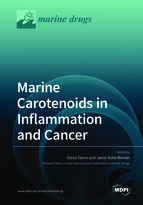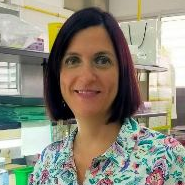Marine Carotenoids in Inflammation and Cancer
A special issue of Marine Drugs (ISSN 1660-3397).
Deadline for manuscript submissions: closed (30 September 2021) | Viewed by 46515
Special Issue Editors
Interests: pharmacology; inflammation; cancer; colon; skin; polyphenols; carotenoids; microalgae; probiotics
Special Issues, Collections and Topics in MDPI journals
Interests: microalgae; Inflammation; oxylipins; Inflammatory Bowel Disease; colon cancer; inflammatory skin diseases
Special Issues, Collections and Topics in MDPI journals
Special Issue Information
Dear Colleagues,
Acute inflammation is a biological response that can arise in organisms in response to pathogens, toxic agents, or tissue damage, with the aim of removing harmful stimuli and restoring tissue homeostasis. Nevertheless, uncontrolled acute inflammation can lead to a chronic inflammatory state, which is believed to play a main role in the pathogenesis of many diseases, including cancer. In this context, an oxidative environment or the presence of reactive oxygen species (ROS) stimulate intracellular signaling pathways and transcription factors, including MAPK and NF-kB, among others. ROS can also activate a multiprotein complex called inflammasome, which regulates the activation of caspase-1 and subsequent maturation of pro-inflammatory cytokines (IL-1β and IL-18). The transcription factor Nrf2 plays a pivotal role in protection against oxidative stress in a multitude of inflammatory diseases since it regulates the transcription of antioxidant enzymes.
Currently, the need to find new anti-inflammatory and anticancer compounds has given rise to a vast number of studies in the marine environment, which represents an excellent source to isolate bioactive molecules, such as carotenoids. Carotenoids are natural isoprenoid pigments synthesized by photosynthetic organisms such as plants, protists, bacteria, heterotrophic bacteria, some fungi, and some invertebrates. In addition, carotenoids have been found in marine organisms, such as algae, and small invertebrates, including sponges, tunicates, bryozoans, and mollusks, as well as microalgae, which are a vast source of carotenoids containing up to 0.2 % of them. Animals require a dietary intake of carotenoids to meet daily health demands because they are unable to synthesize them. There are two subtypes of carotenoids, carotenes (hydrocarbon carotenoids) and xanthophylls (oxygenate derivatives), and they comprise many of the yellow, orange, and red pigments in nature. Currently, lycopene, β-carotene, canthaxanthin, zeaxanthin, astaxanthin, and fucoxanthin are synthesized on an industrial scale for food and cosmetic purposes. Moreover, many of these carotenoids are being studied as chemopreventive agents against inflammation and cancer. This Special Issue of Marine Drugs will cover the entire scope of marine carotenoids with anti-inflammatory and anticancer activities, both in vitro and in vivo, as well as the latest status of clinical development from carotenoids trials. In particular, works that evaluate the molecular mechanisms of these compounds are especially encouraged.
Prof. Elena Talero
Dr. Javier Ávila-Román
Guest Editors
Manuscript Submission Information
Manuscripts should be submitted online at www.mdpi.com by registering and logging in to this website. Once you are registered, click here to go to the submission form. Manuscripts can be submitted until the deadline. All submissions that pass pre-check are peer-reviewed. Accepted papers will be published continuously in the journal (as soon as accepted) and will be listed together on the special issue website. Research articles, review articles as well as short communications are invited. For planned papers, a title and short abstract (about 100 words) can be sent to the Editorial Office for announcement on this website.
Submitted manuscripts should not have been published previously, nor be under consideration for publication elsewhere (except conference proceedings papers). All manuscripts are thoroughly refereed through a single-blind peer-review process. A guide for authors and other relevant information for submission of manuscripts is available on the Instructions for Authors page. Marine Drugs is an international peer-reviewed open access monthly journal published by MDPI.
Please visit the Instructions for Authors page before submitting a manuscript. The Article Processing Charge (APC) for publication in this open access journal is 2900 CHF (Swiss Francs). Submitted papers should be well formatted and use good English. Authors may use MDPI's English editing service prior to publication or during author revisions.
Keywords
- Carotenoids
- Anti-inflammatory
- Anticancer








